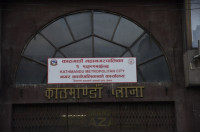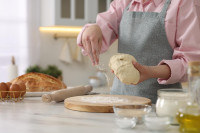Food
I attempted to grow strawberries in Kathmandu, but not all went according to plan
A week passed, and I spent the days learning the best ways to nurture a young strawberry plant while they were struggling to be firmly rooted. Other days, I maintained a vigil over the crate they were planted in.
Prahlad Rijal
This isn’t a sad story, rather a bittersweet symphony—a year in the life of a novice gardener who dared to grow lush, red, delicious strawberries in Kathmandu.
So it began, last October, on a rainy and stormy day of deadlines on stories about corruption, murderers, rapists, swindlers and other crimes. Like my mind, the window shook, the wind stretched it as far as its bolts would allow, and as it was about to slam back and disturb the men talking politics inside the dark smoking-quarters of the newsroom, I clipped it and it remained as it was. Out the window, I spied a vase on the adjoining terrace, with the runners of a delicious fruit snaking out.
At that time, I needed a new hobby and after mixed success in nurturing some flowers, it was time for me to raise the stakes and grow a fruit, an expensive one. In this federal capital, this city that cries out for free space, growing fruit can indeed be a sign of real success.
And so, I requested the office clerk to fetch me runners of the strawberry plant.
To my surprise, he brought back not one but two, taking not more than five minutes to run down a five-storey building and climb another five storeys to the adjoining terrace. I had the plant and it looked desperate to grow in a new home, a new vessel. And I too was as eager as a geneticist in a lab coat assigned to study the genes of some microbes that had landed on a meteorite.
As they say, you have to be cruel to be kind. To grow the plants as big as they could get, I needed a container, not a small vase, and it came at a cost.
I had to displace my pet guinea pig from its bed—a large crate of the kind that fruit vendors load onto Nepal Yatayat early in the morning and rush to Kalimati to haul fruits in. Snoop did not know what was going to become of its bed.
The whole operation happened at night, when a journalist reaches home. For gardening contingencies, my mother has a habit of stocking mud, which I used to fill the container. My plants were now rooted, free of suffocation inside a bag that bumped every time I rode through potholes in this wretched city.
A week passed, and I spent the days learning the best ways to nurture a young strawberry plant while they were struggling to be firmly rooted. Other days, I maintained a vigil over the crate they were planted in.
Logistically, it was challenging. So I decided to do it the Nepali way—mal jal garne. Observe and if need be, intervene. I did not let grass surround the plants to avert the spillage of all the raw energy, rain, mud and minerals. I wanted the fruits to be as ‘mitho’ as a fresh and juicy Amrapali mango.
I stole some homemade fertiliser from my mother. Every cup of tea she drank had a part to play. I fed my strawberry plant with organic fertiliser, only once in a blue moon, because again, as they say, too much love can spoil you.
A few months later, the plant produced buds—tiny, light green buds, awaiting the perfect season. But winter was not coming—it was already here. And I was afraid, whether my plants would wither in the cold. But like my grit, their desire to grow was strong—they faced the cold rain and days of drought, seeming happy whenever I quenched their thirst.
But the buds did not grow. The runners were out, with leaves, but the buds were as tiny as they were a month ago.
Where did I go wrong? Is Kathmandu not the best place to grow strawberries? These questions bothered me for quite some time.
But spring came soon, and I was happy and hopeful. The buds had started to grow. But they turned brown, not red like a strawberry, but rotten, rough brown cockleburs—like the ones you picked while en route to school and threw at your classmates’ hair.
Thankfully, Google saved me from my misery. No, the leaves and the runners were exactly how they were supposed to look like.
Mid-spring, I went to check on the crate—new buds had grown and bigger this time. I began to fantasise about how red the first berries would be, how sweetly would they dissolve in my muzzle.
I could be a strawberry farmer, someday, I thought. I was that confident.
I wanted to see the first green strawberries, but in my pride and vanity, I somehow forgot to check the plant or the crate. And last week, my mother who is a careful and modest gardener, told me that one fruit was looking deliciously red.
I rushed, climbing three stairs at once to reach the terrace. But alas, ghastly agony filled me. I was gazing at the murdered remains of a deliciously red strawberry, pecked to death by a bird that had not contributed anything to the growth but only enjoyed the fruit. Anger ran down my spine.
People take photos in moments of happiness or sadness, or when they get served a plate of nasty-looking laphing. That seems to be the norm these days. Click and upload.
But there I was, taking a photo of a strawberry that took me a year to grow. I took the shot, not in happiness, but to have evidence of the destruction that a bird terrorist had wrought on my plants.
I sent the photos to my father, who knew of my mission. He laughed—three sets of emojis, all laughing. “Let her enjoy,” he wrote.
Somehow, my anger dissipated.
I was happy for that lucky bird and sad at the same time that I hadn’t had an opportunity to taste that first, beautiful and complete berry.
Then, a memory came unbidden.
Once, in my early adolescent years, I had catapulted a slick round pebble and hit a bird—a small dove resting on a neem tree branch, a few metres outside my porch. It died, I killed it. I was the negative variable that death played in the bird’s life equation.
The bird’s mother came and hovered around our terrace for a few days, letting out a plaintive, mourning cry. To this very day, I feel an immeasurable guilt for killing her child.
Fifteen years later, some bird had now found its food because of me. Even if that does not absolve me of my crimes, it marks a transition in my life. I might not have tasted that strawberry, but a bird did. And I had fed a soul.




 24.02°C Kathmandu
24.02°C Kathmandu










